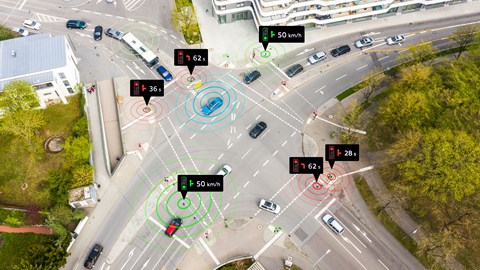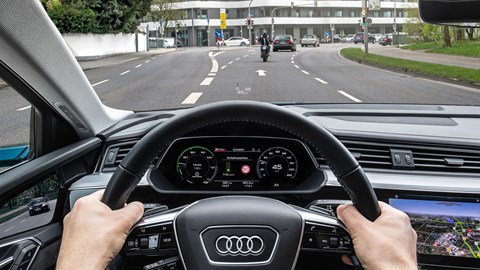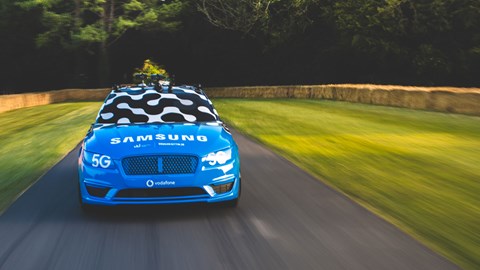► Why 5G is the kickstart autonomous cars need
► As fast as a camera flash
► Will be viable in 2025
Witnessing a Lincoln MKZ, windows blanked out, charging up the hill at Goodwood guided by a driver sat hundreds of yards away, was a foretaste of a connected future that could soon be the present day.
Drift champion Vaughn Gittin Jr’s demonstration was a fun, vivid way to highlight what connectivity can mean. Self-driving cars. Cars that communicate directly with other cars, and with satellites, and with traffic lights – all this is starting to happen, and is set to revolutionise our lives over the next decade.
What are the levels of autonomous cars?
The key to it all is 5G, the latest generation of wireless technology. By using radio waves in previously under-used parts of the spectrum, 5G brings many benefits. It allows us to do what we currently do on our phones more quickly and reliably. It lets more devices go online without slowing everything down. And it opens up a new realm of possibilities – some scarily familiar from dystopian sci-fi movies, others much more benevolent, such as constant real-time monitoring of heart patients.

And self-driving cars. If 5G really can be relied on to provide a strong, uninterrupted signal, with negligible latency (the time it takes to get a response to information sent), then many of the technical challenges around autonomy can be overcome.
According to Professor Rahim Tafazolli, head of the University of Surrey’s 5G Innovation Centre, the only limit to 5G’s applications is our imagination… and the cost of its roll-out.
Let’s hear the numbers
The 4G systems we’re familiar with on our mobiles operate with a throughput of about 1 Gbps – one gigabit (1,000,000,000 bits) per second – and a bandwidth of 20 megahertz, or 20 million cycles per second. ‘Trouble is, we’ve run out of capacity with 4G,’ says Peter Claydon, director of AutoAir, a British project developing automotive 5G. That’s why your phone keeps dropping its connection in crowded venues.
By contrast, 5G has the potential to be developed up to 100 MGHz bandwidth and a data rate of 20 Gbps, although some field trials have demonstrated in excess of 70 Gbps and the University of Surrey has achieved an incredible one trillion bytes per second over 100 metres in the lab.
This is where the ‘smart’ bit comes in, as Professor Tafazolli explains: ‘Because of 5G’s wider bandwidth we will have the capacity to connect one million devices per square kilometre. This aspect, with guaranteed low latency, together with artificial intelligence, is the big differentiator between 5G and previous generations of systems; no other technology exists that can compete with 5G.’

The reduced latency compared to 4G is vital to the development of autonomous vehicles. The current 20 milliseconds is slashed to 1ms – the equivalent of a camera flash.
When and how?
Now, up to a point. Thousands of base stations are ready in place in major cities, waiting for phone customers to upgrade their handsets. Globally, the UK ranks in the top five in terms of base stations and has more than any other individual European country, claims Tafazolli.
Currently the main operators are offering 5G chiefly for entertainment. You can download an HD movie in three minutes, compared to 15 using 4G. If you can bring improvements like that into the automotive world, self-driving cars are in business.
One of the densest locations is the Millbrook Proving Ground, where AutoAir is developing 5G for automotive use and has a mobile mast every quarter of a mile for blanket coverage. ‘We’re looking at mutual hosting, where one organisation sets up a network and others pay to use it,’ says Claydon, adding: ‘Because the transmitters are low-powered we’re considering deploying them on lamp posts and telegraph poles.’

There’s always a but…
The transmitters need line of sight to work effectively, and need to ‘see’ more than one other transmitter at a time. So on a straight stretch of motorway there would be one positioned every half a mile, but they would need to be closer on curves. In cities they would have to be on every corner as 5G can’t ‘see’ through buildings.
Rural areas present a problem, but Tafazolli says that could be overcome by the middle of the next decade by using a combination of terrestrial stations and satellites, with the receivers seamlessly roaming between them.
Daimler’s Dr Nikolaus Kleiner, responsible for Mercedes-Benz driver assist systems and driverless cars, maintains 5G isn’t vital for autonomous cars because a mobile network can ‘never guarantee a reliable connection… and an autonomous car always needs to be 100 per cent safe.’
Both Claydon and Tafazolli are adamant that only 5G can deliver fully autonomous driving, although they do differ on some of the details. But they’re all agreed on one thing: from 2025 onwards, new cars will become a mobile entertainment hub with 3D films and virtual reality instantly streamed into the cabin, and software will play an ever larger role in driving.